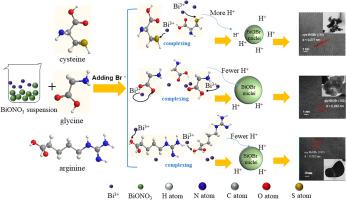Journal of Hazardous Materials ( IF 13.6 ) Pub Date : 2021-02-26 , DOI: 10.1016/j.jhazmat.2021.125544 Yingying Chen , Hailin Tian , Wenxue Zhu , Xin Zhang , Ruiping Li , Chuncheng Chen , Yingping Huang

|
Cefazolin (CFZ) is widely present in the wastewater treatment effluents and in receiving waters and has caused severe impacts to the ecosystem. CFZ degradation by photocatalysis has attracted increasing attention due to its eco-friendly features. Herein, we presented a green synthesis strategy for a highly active BiOBr photocatalyst for CFZ removal with L-cysteine as a directing agent, and the role of thiol in cysteine for facets control and morphology regulation was discussed. We found that the photoactivity of cysteine-induced BiOBr nanosheet was much higher than those prepared by using arginine and glycine as directing agent. Further experiments showed that the cysteine preferentially coordinated Bi3+ with thiol rather than carboxyl. The strong interactions of thiol group with the external surface of the BiOBr crystals stabilize the small crystals that have high surface energy without the cysteine. Such a chemical environment favors forming BiOBr crystalline with small size of high surface area and oriented growth in [110] direction, which facilitates the photogenerated electron-hole separation to achieve significantly promoted photocatalytic activity. Moreover, the cysteine-directed BiOBr nanosheets displayed good photoreactivity to more pollutants (i.e. rhodamine B, cefradine and cefoperazone sodium) and excellent reusability as verified via seven consecutive recycle experiments. The proper photocatalyst dosage (0.4 g/L), relatively acidic water environment (pH 3.4) and high temperature (35 °C) would be beneficial to CFZ photodegrdation by BiOBr. Also, the CFZ photodegradation mechanism and degradation pathway were also proposed by combining radical trapping experiments and electron spin resonance (ESR) test with LC-MS analysis in the photocatalytic process.
中文翻译:

l-半胱氨酸指导BiOBr纳米片的合成以实现有效的头孢唑啉光降解:硫醇的关键作用
头孢唑林(CFZ)广泛存在于废水处理废水和接收水中,并对生态系统造成了严重影响。由于其生态友好的特性,通过光催化降解CFZ引起了越来越多的关注。在这里,我们提出了一种高活性的BiOBr光催化剂的绿色合成策略,该光催化剂以L-半胱氨酸为导向剂去除CFZ ,并讨论了半胱氨酸中巯基在刻面控制和形态调节中的作用。我们发现,半胱氨酸诱导的BiOBr纳米片的光活性比以精氨酸和甘氨酸为导向剂制备的光活性高得多。进一步的实验表明,半胱氨酸优先配位Bi 3+与硫醇而不是羧基。巯基与BiOBr晶体外表面的强相互作用稳定了具有高表面能而没有半胱氨酸的小晶体。这种化学环境有利于形成BiOBr晶体,该晶体具有较小的高表面积和在[110]方向上定向生长,从而促进了光生电子-空穴的分离,从而显着提高了光催化活性。此外,半胱氨酸定向的BiOBr纳米片对更多的污染物(如罗丹明B,头孢拉定和头孢哌酮钠)表现出良好的光反应性,并具有出色的可重复使用性,这已通过七个连续的循环实验进行了验证。适当的光催化剂用量(0.4 g / L),相对酸性的水环境(pH 3。4)和高温(35°C)将有利于BiOBr对CFZ的光解作用。此外,通过将自由基捕获实验和电子自旋共振(ESR)测试与LC-MS分析相结合,在光催化过程中还提出了CFZ的光降解机理和降解途径。



























 京公网安备 11010802027423号
京公网安备 11010802027423号